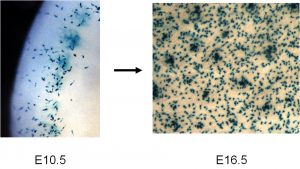Our research focuses on the biology of melanocytes, the cells that pigment the skin, eyes, and hair. One major emphasis of the lab is the study of uveal melanoma, the most common intraocular cancer, which arises from melanocytes in the eye. Uveal melanoma has no effective treatment options in metastatic cases. With our colleagues, we identified the first oncogenes that drive uveal melanoma formation in people: GNAQ and GNA11. These two closely related heterotrimeric G protein alpha subunits are mutated in a mutually exclusive pattern in most cases of uveal melanoma. Our lab engineered the first GNAQ knock-in mouse model, which expresses the oncogenic version of GNAQ in a tissue-specific manner. When directed to melanocytes, the mice develop the same subset of melanocytic lesions that bear GNAQ mutations in humans. This mouse model will be be useful for understanding the signaling pathways downstream of GNAQ in melanoctyes and testing new therapeutic agents. We are also interested in how melanocytes develop, particularly how the different developmental lineages of melanocytes contribute to the diversity of melanoma subtypes. Several projects are underway to understand how metalloproteases shape the extracellular matrix around melanocytes, regulating growth and cell migration during various developmental and postnatal stages. We welcome applications for undergraduate, graduate, and postdoctoral research positions in the lab. If interested, email cvr@mail.ubc.ca.



